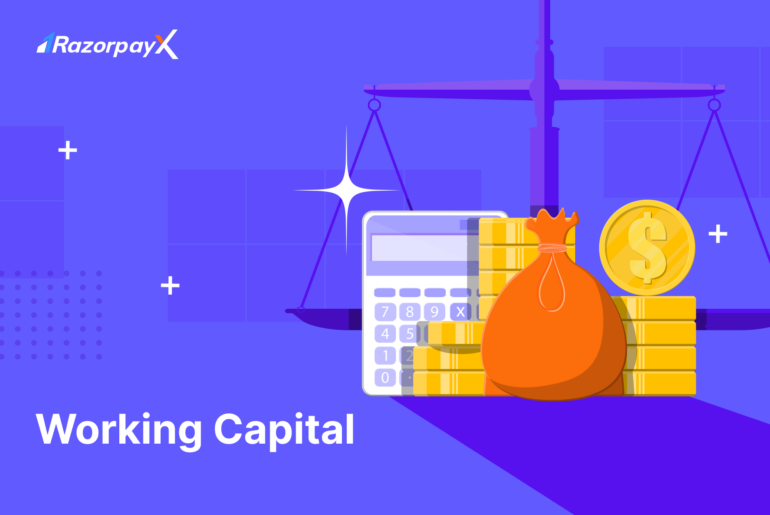What is Working Capital?
In accounting terms, working capital is the difference between a company’s current assets and current liabilities. This difference is used to fund daily operations and meet short-term obligations.
Having the right balance of working capital is very important to the good financial health and performance of a business. Let’s understand how working capital works and why exactly this financial metric is so important.
Understanding Working Capital
 Working capital is calculated from the current assets and current liabilities of a business. The difference gives us the working capital.
Working capital is calculated from the current assets and current liabilities of a business. The difference gives us the working capital.
- Current assets include everything a business owns that can be converted into cash very quickly – the most liquid of assets, like market securities and deposits.
- Current liabilities include those debts that mature within one operating cycle, like vendor payments or accounts payable.
A negative working capital means the business runs the risk of defaulting on loans and low liquidity. This happens when the business has more current liabilities than current assets.
A positive working capital means the business is able to fund its operations and growth. This happens when the business has more current assets than current liabilities.
However, a very high positive working capital is also not a good thing. It means the business has too much idle cash sitting around, which could be put to better use, or that it has too much inventory that isn’t moving fast enough.
Components of Working Capital
Working capital can be calculated from the difference between current assets and current liabilities. Both these values are found on the balance sheet of a company.
Current Assets
Current assets are the most liquid assets a company owns. “Liquid” here means that these assets can be converted into cash very quickly. They are unlike land or machinery, which are fixed assets and cannot be converted into cash very easily.
They are found under the Assets section of the Balance Sheet. Current assets include some or all of the following, depending on the type of business and industry of operations.
- Cash & Cash Equivalents
- Accounts Receivable
- Inventory
- Marketable Securities
Current Liabilities
Current liabilities are debts that mature within the next 12 months. They have to be paid off within a year or the business runs the risk of default. Generally, businesses use current assets like cash to pay off current liabilities.
They are found under the Liabilities section of the Balance Sheet, and include some or all of the following.
- Accounts Payable
- Salary Payable
- Dividend Payable
- Accrued Tax Payable
- Current portion of long-term debt
Working Capital Formula
The formula to calculate working capital is:
Working Capital = Current Assets – Current Liabilities
If the final number is a negative value, it means that the current liabilities are more than the current assets. Negative working capital means that the company does not have enough liquid cash to cover its short-term debts and runs the risk of default.
If the final number is a positive value, it means that the business does indeed have enough liquid cash to cover its short-term debts.
Limitations of Working Capital
Although working capital is mostly a reliable indicator of short-term liquidity, there are some limitations that must be kept in mind when using this metric to gauge a business’s performance.
- Working capital includes accounts receivable, which is an unreliable source of cash and cash equivalents, since the vendors might not pay the business back.
- Businesses with a significant accounts receivable balance risk overestimating their cash and cash equivalents.
- The daily liquidity of a business changes quite rapidly even over the span of one day.
- By the time the assets and liabilities of the business are valued and recorded, the amounts might be obsolete. This may give an incorrect working capital value.
Working Capital Calculation
ABC Manufacturing
| Current Assets | Cash | 1,00,000 |
| Inventory | 2,00,000 | |
| Accounts Receivable | 2,00,000 | |
| Total Current Assets | 5,00,000 | |
| Current Liabilities | Accounts Payable | 2,00,000 |
| Short-term Debt | 1,00,000 | |
| Total Current Liabilities | 3,00,000 |
ABC Manufacturing has current assets of Rs 5,00,000. They also have current liabilities of Rs 3,00,000. To calculate the working capital, subtract the current liabilities from the current assets:
Working Capital = Current Assets – Current Liabilities
Working Capital = Rs 5,00,000 – Rs 3,00,000
Working Capital = Rs 2,00,000
In this example, ABC Manufacturing has a working capital of Rs 2,00,000. This represents the amount of capital available to the company to fund its day-to-day operations and meet its short-term obligations.
This positive working capital indicates that the company has sufficient current assets to cover its current liabilities, which is generally considered favourable for financial stability.
How Can a Business Improve its Working Capital?
Since working capital depends on the value of current assets and current liabilities, a surefire way to improve a business’s working capital is to increase current assets and decrease liabilities.
Of course, this is in the case of a negative working capital, where the business’s current liabilities are more than its current assets.
- Avoid debt as much as possible
- Reduce expenses to the bare minimum
- Build higher inventory reserves
- Prepaying expenses for cash discounts
- Reduce bad debts or debt write-offs by considering vendor credit repayment habits
- Pay vendors on time to avoid fines or late fees
This last point is especially important since paying vendors on time is a surefire way of not only building trust with your vendors but also ensuring that you do not incur any extra expenses.
RazorpayX Vendor Payments is an automated tool to help businesses pay and manage their vendors seamlessly with very minimal manual input.
It comes along with RazorpayX’s other full-stack tools for startups, like Current Accounts, Corporate Credit Cards, Bulk Payouts, and more.





